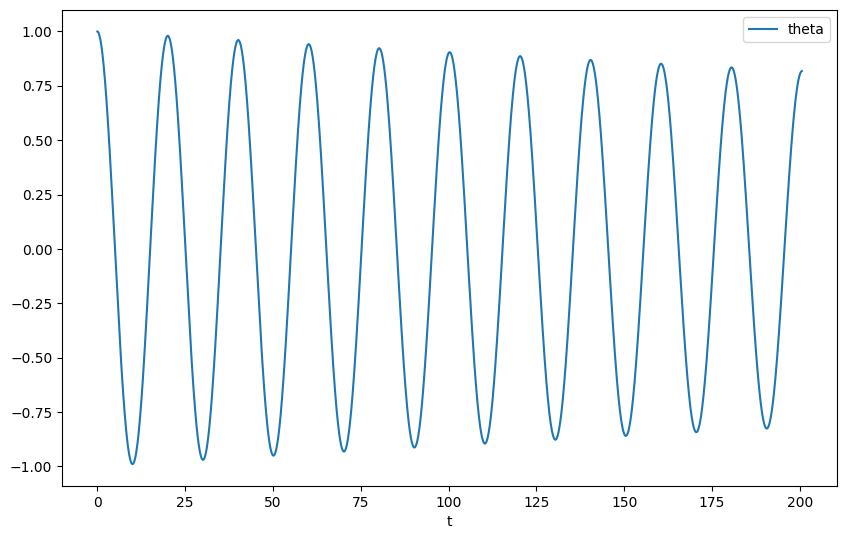Pendulum Dataset¶
We create a synthetic dataset based on the physical model called pendulum. The pendulum is modeled as a damped harmonic oscillator, i.e.,
\[
\theta(t) = \theta(0) \cos(2 \pi t / p)\exp(-\beta t),
\]
where \(\theta(t)\) is the angle of the pendulum at time \(t\). The period \(p\) is calculated using
\[
p = 2 \pi \sqrt(L / g),
\]
with \(L\) being the length of the pendulum and \(g\) being the surface gravity.

import math
from functools import cached_property
from typing import Dict, List
import pandas as pd
class Pendulum:
"""Class for generating time series data for a pendulum.
The pendulum is modelled as a damped harmonic oscillator, i.e.,
$$
\theta(t) = \theta(0) \cos(2 \pi t / p)\exp(-\beta t),
$$
where $\theta(t)$ is the angle of the pendulum at time $t$.
The period $p$ is calculated using
$$
p = 2 \pi \sqrt(L / g),
$$
with $L$ being the length of the pendulum
and $g$ being the surface gravity.
:param length: Length of the pendulum.
:param gravity: Acceleration due to gravity.
"""
def __init__(self, length: float, gravity: float = 9.81) -> None:
self.length = length
self.gravity = gravity
@cached_property
def period(self) -> float:
"""Calculate the period of the pendulum."""
return 2 * math.pi * math.sqrt(self.length / self.gravity)
def __call__(
self,
num_periods: int,
num_samples_per_period: int,
initial_angle: float = 0.1,
beta: float = 0,
) -> Dict[str, List[float]]:
"""Generate time series data for the pendulum.
Returns a list of floats representing the angle
of the pendulum at each time step.
:param num_periods: Number of periods to generate.
:param num_samples_per_period: Number of samples per period.
:param initial_angle: Initial angle of the pendulum.
"""
time_step = self.period / num_samples_per_period
steps = []
time_series = []
for i in range(num_periods * num_samples_per_period):
t = i * time_step
angle = (
initial_angle
* math.cos(2 * math.pi * t / self.period)
* math.exp(-beta * t)
)
steps.append(t)
time_series.append(angle)
return {"t": steps, "theta": time_series}
pen = Pendulum(length=100)
df = pd.DataFrame(pen(10, 400, initial_angle=1, beta=0.001))
_, ax = plt.subplots(figsize=(10, 6.18))
df.plot(x="t", y="theta", ax=ax)
We take this time series and ask our model to forecast the next step (forecast horizon is 1).
PyTorch Dataset and Lightning DataModule
In our tutorials, we will use Pytorch lightning excessively.
We defined some useful modules in our ts_dl_utils package
and 
Contributors: